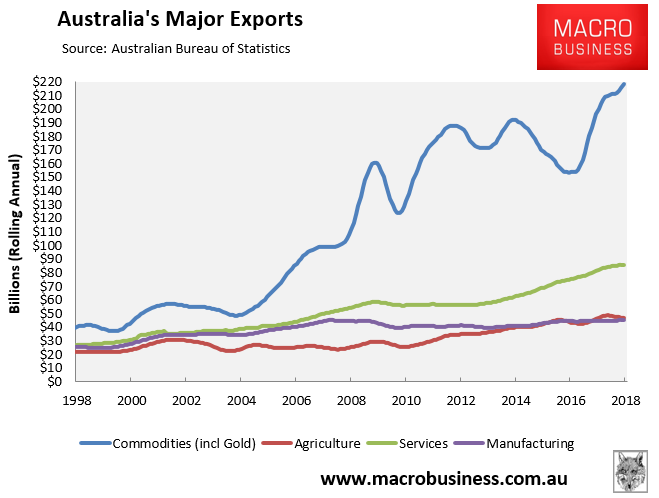Former special adviser to the Reserve Bank of New Zealand (RBNZ) and New Zealand Treasury, Michael Reddell, has cited mass immigration as a prime cause of New Zealand’s weak productivity. From Interest.co.nz:
For decades, New Zealand’s economic Achilles heel has been its low productivity…
GDP per capita remained at just 0.1% in the last quarter…
New Zealand’s productivity levels have been well below the OECD average for some time now…
Independent economist Michael Reddell, who is cited in the Productivity Commission report, says New Zealand’s immigration policy is a key factor in its productivity issues.
He says the high level of net migration has been putting pressure on real interest rates, as large levels of investment have been needed to keep up with all the new people.
In a country with a fairly modest savings rate, Reddell says that puts persistent upward pressure on real interest rates.
That, in turn, has kept the kiwi dollar elevated for years making it harder to export from New Zealand – a major issue for Kiwi firms looking to sell their products to the world.
“The consistent pressure on the real interest rates and the exchange rate squeezes out the opportunities that might otherwise be here,” he says.
This means successful businesses choosing not to set up shop in New Zealand, given the increased costs.
Fewer successful businesses means less innovation, holding New Zealand back from productivity growth in the long term.
Given the similar economic structure and similar mass immigration policy, Reddell’s arguments hold equally for Australia.
That said, there are several other areas where mass immigration is productivity destroying.
The most obvious of these costs is congestion, where the population explosions in Sydney and Melbourne, in particular, have led to worsening congestion over the past decade:
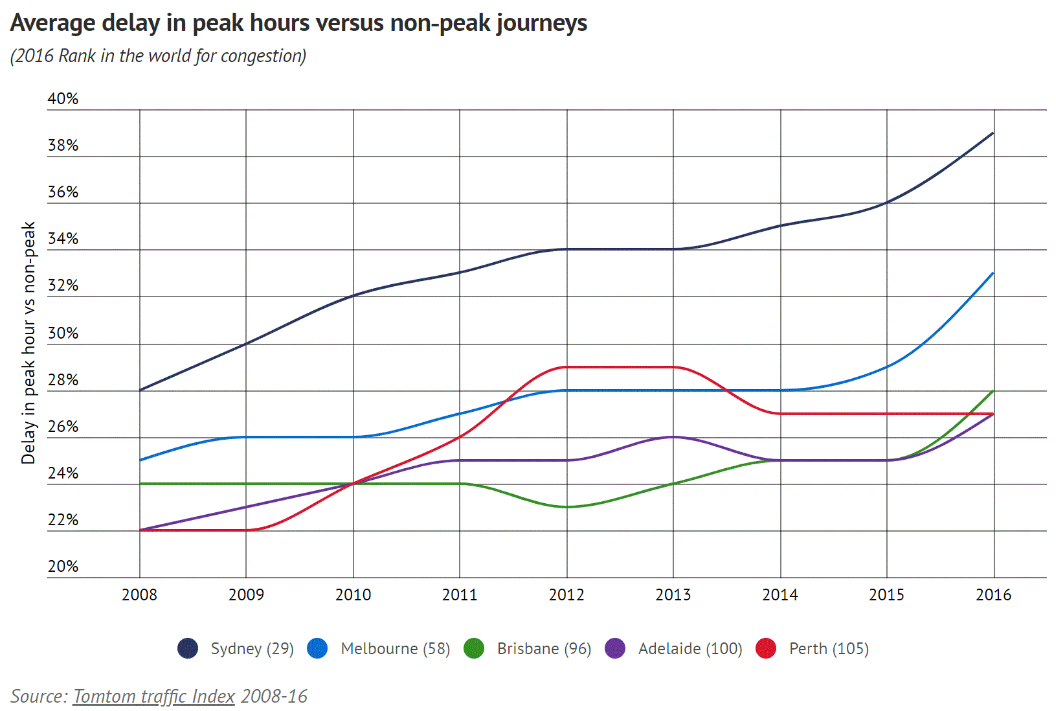
Worse, “avoidable social costs” of congestion are projected by the Bureau of Infrastructure, Transport and Regional Economics to soar as rampant population growth continues to overrun the city’s infrastructure:
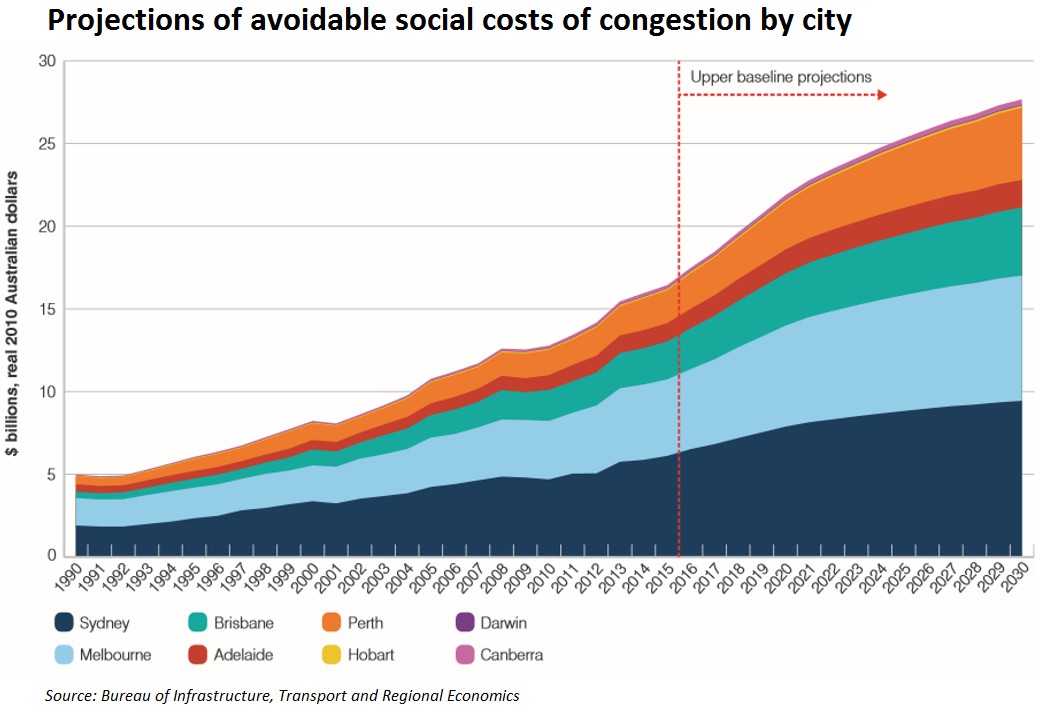
As noted recently by Mike Seccombe in the Saturday Paper:
The Bureau of Infrastructure, Transport and Regional Economics estimates the “avoidable” social costs of traffic congestion in the eight Australian capitals cities. They reckoned it to total $16.5 billion in the 2015 financial year, up from $12.8 billion in the 2010 financial year. By 2030, they forecast, the cost of congestion would rise to between $27.7 billion and $37.3 billion. That is roughly the cost of the National Disability Insurance Scheme, fully implemented.
Another area where mass immigration is productivity destroying is the escalating cost of infrastructure. In order to keep pace with Australia’s projected population explosion, the Productivity Commission (PC) in 2013 estimated that total private and public investment requirements over the next half century will need to be more than 5-times the cumulative investment made over the last half century:
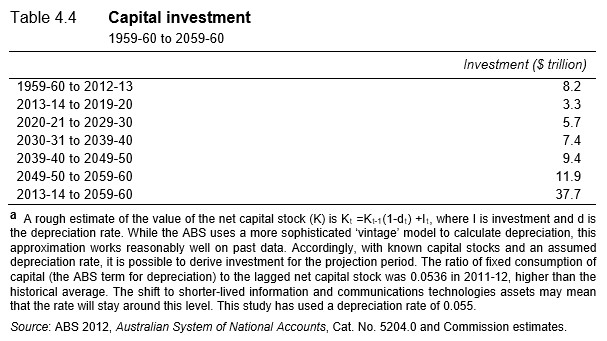
Moreover, because most migrants settle in Sydney and Melbourne, which are already built-out, this makes the cost of retrofitting new infrastructure to accommodate greater population densities prohibitively expensive because of the need for land buy-backs, tunnelling, as well as disruptions to existing infrastructure. These are basic dis-economies of scale.
The escalating cost of infrastructure was made explicit by the PC’s 2016 Migrant Intake into Australia report, which noted:
Physical constraints in major cities make the costs of expanding infrastructure more expensive, so even if a user-pays model is adopted, a higher population is very likely to impose a higher cost of living for people already residing in these major cities.
…governments have not demonstrated a high degree of competence in infrastructure planning and investment. Funding will inevitably be borne by the Australian community either through user-pays fees or general taxation…
In a similar vein, the PC’s more recent Shifting the Dial: 5 year productivity review explicitly noted that infrastructure costs will inevitably balloon due to our cities’ rapidly growing populations:
Growing populations will place pressure on already strained transport systems… Yet available choices for new investments are constrained by the increasingly limited availability of unutilised land. Costs of new transport structures have risen accordingly, with new developments (for example WestConnex) requiring land reclamation, costly compensation arrangements, or otherwise more expensive alternatives (such as tunnels).
Mass immigration also worsens Australia’s current account balance, escalating both national debt and the sale of the nation’s assets.
The lion’s share of Australia’s export revenue comes from commodities and from Western Australia and Queensland in particular:
However, the majority of Australia’s imports and indeed private debt flows to our biggest states (and cities), New South Wales (Sydney) and Victoria (Melbourne), which are also the key magnets for migrants and projected to take the lion’s share of Australia’s population growth.
Increasing the number of people via mass immigration does not materially boost Australia’s exports but it does significantly increase imports (think flat screen TVs, imported cars, etc.). One only needs to look at both New South Wales and Victoria, which have driven huge trade deficits as the extra imports have far outweighed exports:
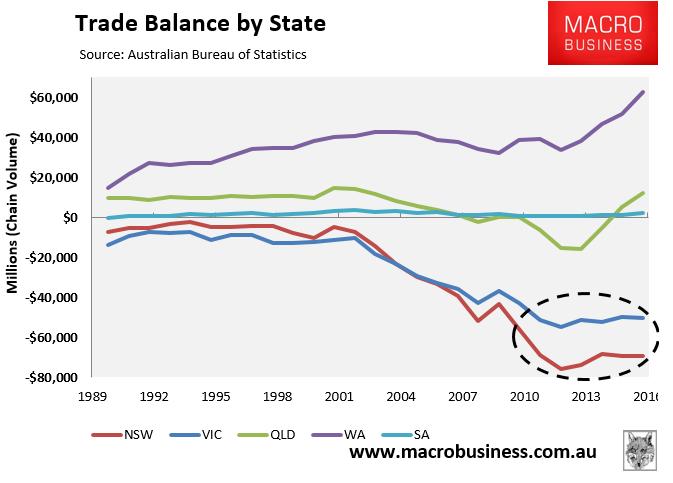
All of these extra imports must be paid for – either by accumulating foreign debt, or by selling-off the nation’s assets. Australia has been doing both.
Australia would improve its trade balance and current account deficit, as well as reduce the need to sell-off assets and binge on debt, if it simply reduced immigration and abandoned the ‘Big Australia’ policy.
Think about it. Australia would still ship the same amount of hard commodities and agriculture regardless of how many people are coming in as all the productive capacity has been set up and it doesn’t require more labour. However, we would import far less.
Essentially, by running a mass immigration program, Australia is diluting its fixed mineral wealth among more people, which necessarily lowers residents’ welfare.
Proponents of mass immigration ignore the above concerns and instead claim that Australia’s productivity is enhanced because migrants are supposedly more productive than locals and, therefore, labour productivity is increased through strong immigration.
However, the actual evidence debunks this view and shows that migrants are generally employed below the level of their qualifications and have lower labour force attachment than the Australian born population (detailed discussion here).
In summary, Australia’s mass immigration program imposes net costs on the Australian economy. Individual living standards are also eroded through rising congestion costs, declining housing affordability, paying more for infrastructure (e.g. toll roads, water and energy), environmental degradation, and overall reduced amenity.

